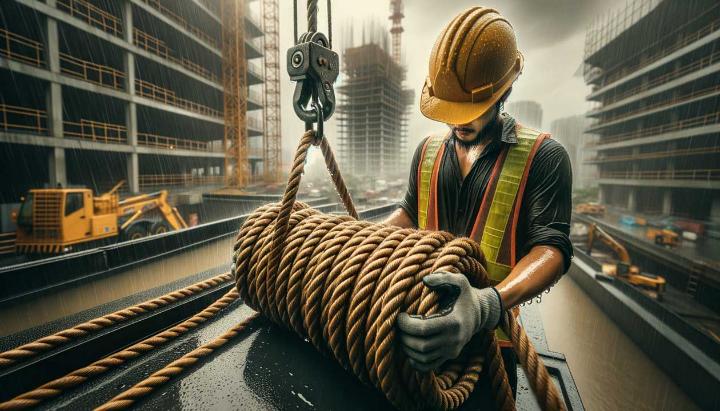Have you ever wondered how a simple rope could revolutionise industries across the globe? Enter manilla rope, the unsung hero of countless applications. From the bustling docks of Sydney Harbour to the rugged Outback farms, this versatile natural fibre has been silently shaping our world for centuries.
Manilla rope, derived from the fibres of the abaca plant, boasts a unique combination of strength, durability, and eco-friendliness that sets it apart in today's synthetic-dominated market. Whether you're a seasoned sailor, an innovative farmer, or a forward-thinking construction manager, the applications of manilla rope are bound to surprise and inspire you.
In this eye-opening exploration, we'll unravel the myriad uses of manilla rope across marine, agricultural, and industrial sectors. From the intricate art of sail rigging to the practical challenges of livestock management, and even the high-stakes world of construction, we'll discover how this humble rope continues to prove its worth in the 21st century.
Join us as we delve into the fascinating world of manilla rope, and learn why this time-tested material remains an indispensable tool for professionals and enthusiasts alike. Whether you're seeking sustainable solutions or simply curious about the hidden heroes of industry, this journey through the versatile uses of manilla rope promises to be an enlightening adventure.
Marine and Boating Applications of Manila Rope
As a sailor, I've come to appreciate the timeless reliability of manila rope in marine environments. This natural fiber rope has been a staple in maritime industries for centuries, and for good reason. Its unique properties make it an invaluable tool for various boating applications, from small pleasure craft to large commercial vessels.
Advantages of Manila Rope in Saltwater Environments
One of the most remarkable features of manila rope is its exceptional resistance to saltwater damage. Unlike some synthetic alternatives, manila rope maintains its strength and integrity even after prolonged exposure to harsh marine conditions. I've seen firsthand how this natural fiber outperforms many modern materials in terms of durability and longevity at sea.
Manila rope's biodegradable nature is another significant advantage. As we become more environmentally conscious, the importance of using sustainable materials in our maritime activities cannot be overstated. It's reassuring to know that if a piece of manila rope accidentally ends up in the ocean, it will naturally decompose without harming marine life.

Common Uses of Manila Rope in Sailing and Boating
Manila rope's versatility shines in various marine applications:
- Mooring and docking: The rope's natural grip and strength make it ideal for securing vessels to docks or buoys.
- Rigging: Its flexibility and resistance to stretching make manila rope excellent for various rigging applications on sailboats.
- Anchor lines: The rope's weight and durability make it a reliable choice for anchor lines, especially in traditional sailing vessels.
Have you ever noticed how different a manila rope feels compared to synthetic alternatives? Its rough texture provides an excellent grip, even when wet - a crucial feature when you're handling lines in choppy conditions.
To ensure your manila rope lasts, proper maintenance is key. After use, rinse it with fresh water and allow it to dry thoroughly. Store it in a cool, dry place away from direct sunlight to prevent degradation. With proper care, a quality manila rope can serve you well for years, becoming a trusted companion on your maritime adventures.
Pro tip: When working with manila rope, always wear gloves to protect your hands from splinters and rope burn. The natural fibers can be rough on bare skin, especially when new or wet.
As we navigate the waters of modern boating, it's worth remembering the time-tested reliability of manila rope. Its natural properties and eco-friendly composition make it a smart choice for conscientious sailors. Whether you're a weekend boating enthusiast or a professional mariner, consider giving this traditional material a try on your next nautical adventure.
Agricultural and Landscaping Applications of Manila Rope
As a farmer and gardening enthusiast, I've discovered that manila rope is not just for sailing - it's a versatile tool that's incredibly useful in agricultural and landscaping settings. The natural strength and durability of 1-inch manila rope make it an excellent choice for various outdoor applications. Let me share some insights on how this remarkable material can enhance your farming and landscaping projects.
Versatile Uses of 1-Inch Manila Rope in Farming
On my small farm, I've found countless uses for 1-inch manila rope. Its robust nature and resistance to weathering make it ideal for agricultural tasks:
- Livestock management: I use manila rope to create temporary pens or lead lines for cattle and horses. Its strength gives me peace of mind when handling larger animals.
- Crop support: In my vegetable garden, manila rope serves as excellent support for climbing plants like beans and peas. It's strong enough to hold heavy produce and doesn't cut into the plant stems.
- Hay bale binding: When storing hay, I've found manila rope to be perfect for securing bales. It's easy to tie and untie, even after months of storage.
What I love most about using manila rope on the farm is its eco-friendly nature. Unlike synthetic ropes, if a piece breaks off and gets left behind, I know it will biodegrade without harming the soil or wildlife.

Enhancing Outdoor Spaces with Manila Rope Landscaping
Beyond farming, manila rope has become my secret weapon in creating beautiful, rustic landscapes. Here are some creative ways I've incorporated it into my garden designs:
- Natural fencing: I've used 1-inch manila rope to create charming rope fences, perfect for defining garden boundaries or creating cozy nooks.
- Hanging planters: The rope's strength makes it ideal for suspending potted plants, adding vertical interest to patios and pergolas.
- Tree support: When planting young trees, manila rope provides gentle yet sturdy support, allowing the tree to grow strong without damage.
One of my favourite landscaping projects was creating a rope-based trellis for climbing roses. The natural texture of the manila rope complemented the delicate flowers beautifully, adding a touch of rustic elegance to my garden.
Pro tip: To extend the life of your manila rope in outdoor settings, treat it with a natural oil like linseed. This helps repel water and prevent rot, especially in damp climates.
Whether you're a hobby gardener or a professional landscaper, I encourage you to explore the potential of manila rope in your outdoor projects. Its versatility, strength, and eco-friendly nature make it an excellent choice for creating functional and beautiful spaces. Have you used manila rope in your garden or farm? I'd love to hear about your experiences and creative ideas!
Industrial and Construction Applications of 2 manilla rope
As a construction site manager with over a decade of experience, I've seen firsthand the incredible versatility and reliability of 2-inch manila rope in various industrial settings. This natural fiber powerhouse, derived from the abaca plant, has become an indispensable tool in our industry. Let me walk you through the remarkable properties and applications of this robust material.
Strength and Durability Benefits
The 2-inch manila rope boasts an impressive tensile strength of around 2,350 pounds, making it a go-to choice for heavy-duty applications. Its 3-strand twisted construction provides excellent resistance to abrasion and stretching, ensuring longevity even in harsh conditions. I've often marveled at how this natural fiber outperforms many synthetic alternatives in certain scenarios.
One of the most striking features of manila rope is its ability to maintain grip even when wet. This characteristic has saved the day on numerous rainy construction sites, where slippery conditions can pose significant safety risks. The natural fibers also absorb shock well, reducing the risk of sudden breaks under dynamic loads.

Common Uses in Construction and Industry
The applications of 2-inch manila rope in construction and industry are truly diverse. Here are some of the most common uses I've encountered:
- Lifting and hoisting materials: The rope's strength makes it ideal for lifting heavy construction materials. I've used it countless times to hoist lumber, steel beams, and even large machinery components.
- Scaffolding support: Manila rope serves as an excellent safety measure in scaffolding setups, providing both support and a means of emergency descent if needed.
- Temporary barriers: We often use manila rope to create quick, effective safety barriers around construction zones. Its visibility and strength make it perfect for this purpose.
- Pulley systems: The rope's low stretch properties make it ideal for creating efficient pulley systems for moving materials vertically or horizontally on a construction site.
One project that stands out in my memory involved using 2-inch manila rope to create a temporary rope bridge across a ravine for equipment transport. The rope's strength and natural grip provided a safe and effective solution in a challenging environment.
Pro tip: Always inspect your manila rope before each use, especially in load-bearing applications. Look for signs of fraying, discoloration, or unusual stiffness, which could indicate weakening of the fibers.
While synthetic ropes have their place in modern construction, the unique properties of manila rope ensure its continued relevance. Its biodegradability is an added bonus in our increasingly eco-conscious industry. Have you considered incorporating manila rope into your construction or industrial projects? I'd love to hear about your experiences or any questions you might have about using this versatile material.
For more on the benefits of both natural and synthetic ropes, check out Synthetic vs Natural Fiber Ropes: Which is Best?. Additionally, explore how synthetic options can complement your needs with our article on why synthetic rope outperforms winch wire rope.
Discover the diverse applications of manilla rope, a durable and eco-friendly material celebrated for its strength and versatility across various industries. From marine and boating tasks, where its resistance to saltwater damage and strong grip is key, to agricultural uses such as livestock control and plant support, manilla rope is an indispensable tool. In industrial and construction settings, 2-inch manilla rope excels at lifting, securing loads, and creating safety barriers. Its natural, biodegradable composition makes it an environmentally conscious choice for modern needs. Explore the benefits and unique properties of manilla rope for your projects today.
Get Customised Solutions for Your Rope Needs
Fill in the form above to learn more about how iRopes can provide high-quality, customised rope solutions tailored to your specific requirements. Our experts are ready to assist you with versatile and durable manilla rope options for marine, agricultural, or industrial applications.